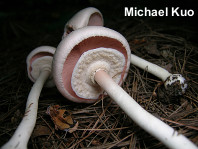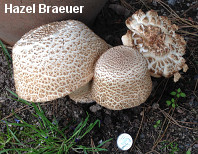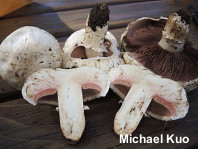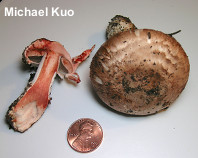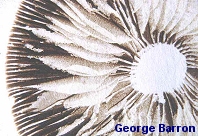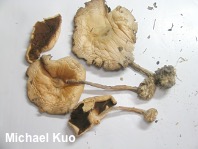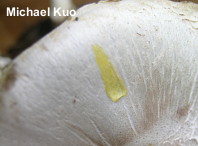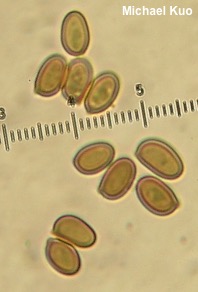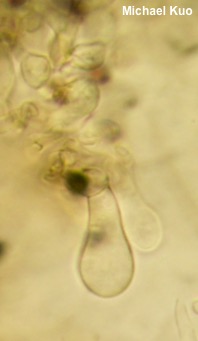Key to 100 Agaricus species, subspecies, and varieties in North America 
| 1. | Flesh when sliced turning pink to red under normal conditions (in very wet weather some species appear to stain pink when they would not normally do so). | 2 |
| 1. | Flesh not staining pink to red under normal conditions. | 48 |
| 2. | Not associated with Monterey cypress. | 12 |
| 3. | Cap white or nearly so. | 4 |
| 4. | Red staining prompt and intense; stem shaggy below the ring. | Agaricus benesii |
| 4. | Red staining slow and faint to moderate; stem not shaggy. | |
| 5. | Cap conical to broadly conical; underside of ring dark brown. | Agaricus fuscovelatus |
| 5. | Cap convex to planoconvex; underside of ring whitish to brownish or yellow but not dark brown. | 6 |
| 6. | Large mushrooms (caps 6–25 cm across); flesh purplish pink when sliced; underside of ring often developing yellow stains and patches; refrigerated specimens developing orange, red, and purple shades. | Agaricus lilaceps |
| 6. | Small to medium sized mushrooms (caps 4–15 cm across); flesh pink to red when sliced; underside of ring not yellowing; refrigerated specimens not developing notable colors. | 7 |
| 7. | Mature cap small (2–3 cm across), brown and finely fibrillose; rare. | Agaricus rubroanus |
| 7. | Mature cap larger than 2–3 cm across, variously colored and textured; rare or common. | 8 |
| 8. | Stem shorter than, or about equal to, the width of the cap. | 9 |
| 8. | Stem longer than the width of the cap. | 11 |
| 9. | Mushroom usually stocky; cap developing fine brown scales. | |
| 9. | Mushroom with the stature of store-bought mushrooms ("button mushrooms," "portobellos"); cap bald or with appressed fibrils. | 10 |
| 10. | Red staining faint to moderate; basidia 2-spored. | |
| 10. | Red staining intense; basidia 4-spored. | Agaricus arginferus |
| 11. | Cap and stem pale tan to buff; ring thin and fragile; stem becoming hollow, without ringlets near the base. | Agaricus cupressophilus |
| 11. | Cap medium to dark brown, stem white; stem not hollowing, often featuring one to several brownish ringlets near base. | |
| 12. | Found in Rocky Mountain forests (including pinyon-juniper forests). | 13 |
| 12. | Found elsewhere (including non-forest Rocky Mountain locations). | 21 |
| 13. | Associated with Rocky Mountain juniper in semi-arid, pinyon-juniper forests; staining strongly red; cap with overlapping scales and edge adorned with hanging tissue. | Agaricus hupohanae |
| 13. | Associated with spruces, firs, or pines at higher elevations; red staining strong or weak; cap lacking overlapping scales; cap edge with hanging tissue or not. | 14 |
| 14. | Cap white or nearly so. | 15 |
| 15. | Red staining moderate to pronounced. | 17 |
| 16. | Flesh very firm and hard; odor not distinctive; truly woodland, associated with spruces; spores broadly ellipsoid. | Agaricus devoniensis
subsp. bridghamii |
| 16. | Flesh not notably firm and hard; odor faintly briny; ecology poorly documented but likely appearing only in meadows near woodlands; spores subglobose or broadly ellipsoid. | Agaricus pilosporus |
| 17. | Cap 6–12 cm across; stature stocky (stem about as long as the cap is wide, or shorter); most spores over 5 µm long. | Agaricus subfloccosus |
| 17. | Cap 2.5–4 cm across; stature not stocky; most spores under 5.5 µm long. | Agaricus sylvaticus
subsp. occidentalis |
| 18. | Stature stocky (stem about as long as the cap is wide, or shorter); cap very pale brown. | Agaricus subfloccosus |
| 18. | Stature not stocky (mature stem usually longer than the width of the cap); cap pale to dark brown. | 19 |
| 19. | Cap 2.5–4 cm across, bald or only slightly appressed-fibrillose; most spores under 5.5 µm long. | Agaricus sylvaticus
subsp. occidentalis |
| 19. | Cap larger than above, appressed fibrillose to scaly; most spores more than 5 µm long. | 20 |
| 20. | Cap with small scales with uplifted tips; red staining usually faint. | Agaricus cordillerensis |
| 20. | Cap appressed fibrillose, sometimes in old age developing large, appressed scales; red staining usually pronounced, and often brownish red. | |
| 21. | Growing in grass (lawns, meadows, pastures, etc.), disturbed-ground settings like ditches and roadbeds, compost heaps, landscaping areas, and so on. | 22 |
| 21. | Growing in woods—or growing in association with trees in urban parks or lawns, in grass or not. | 32 |
| 22. | Cap white or nearly so. | 23 |
| 23. | Cap surface bruising red, then brown; often growing in clusters; known from California and Mexico. | Agaricus subsubensis |
| 23. | Cap surface, if bruising red, not then changing to brown; not growing in clusters; variously distributed. | 24 |
| 24. | Red staining primarily limited to base of stem; odor faintly briny; spores often subglobose. | Agaricus pilosporus |
| 24. | Red staining not restricted to stem base; odor briny or not; spores subglobose or ellipsoid. | 25 |
| 25. | Odor briny; appearing in sandy, coastal areas and in the Denver area. | |
| 25. | Odor not briny; variously distributed. | 26 |
| 26. | Stem lacking a ring but featuring a basal volva; known from Maryland. | Agaricus pequinii |
| 26. | Stem with a ring; variously distributed. | 27 |
| 27. | Flesh tough; ring sheathing the stem; gills usually becoming brown without a pink stage; often growing in hard-packed soil and road beds. | |
| 27. | Flesh not notably tough; ring not sheathing; gills becoming pink, then brown; often found in lawns and compost piles (and in grocery stores). | |
| 28. | Cap bald; stem lacking a ring but featuring a basal volva; spores subglobose; known from Maryland. | Agaricus pequinii |
| 28. | Cap fibrillose to scaly; stem with a ring; spores ellipsoid; variously distributed. | 29 |
| 29. | Cap 2–5 cm across, broadly bell-shaped; spores longer than 7.5 µm; known from Ontario. | Agaricus erindalensis |
| 29. | Cap larger than above, usually convex; spores variously sized; variously distributed. | 30 |
| 30. | Cap distinctly scaly with fine, coppery brown scales; most spores under 6 µm long; known from Tennessee. | Agaricus tennesseensis |
| 30. | Cap bald to fibrillose but not finely scaly; most spores longer than 6 µm; variously distributed. | 31 |
| 31. | Cap reddish brown, fibrillose; spores longer than 8 µm; basidia 4-spored; known from Santa Cruz County, California. | Agaricus depauperatus |
| 31. | Cap tan to dark brown but not reddish brown, fibrillose or not; spores shorter than 8 µm; basidia 2-spored; potentially widely distributed (native populations are primarily western but escapees from cultivation occur in many places). | |
| 32. | Found from the Rocky Mountains westward. | 33 |
| 32. | Found from the Great Plains eastward. | 42 |
| 33. | Cap white or very pale brown. | 34 |
| 33. | Cap brown to reddish brown. | 36 |
| 34. | Cap flattened in the middle, fairly small (about 4 cm across); known from the Seattle area. | Agaricus bivelatoides |
| 34. | Cap convex, usually larger than 4 cm; variously distributed. | 35 |
| 35. | Red staining pronounced; stem very long (4–13 cm); cap with small concolorous scales toward the edge; found in conifer forests in the Pacific Northwest; basidia 4-spored. | Agaricus albosanguineus |
| 35. | Red staining weak to moderate; stem not notably long; cap scaly or not; variously distributed; basidia 2-spored. | |
| 36. | Associated with western red-cedar; cap reddish brown and fibrillose-scaly; stem with small brown scales below the ring. | Agaricus thujae |
| 36. | Not associated with western red cedar; cap variously colored and textured; stem without small brown scales. | 37 |
| 37. | Associated with Mexican cypress and possibly with other high-elevation cypresses in the southwestern United States; cap gray-brown, 2–8 cm across; stature slender. | Agaricus tlaxcalensis |
| 37. | Not associated with cypresses; cap and stature varying. | 38 |
| 38. | Associated with various conifers in the San Francisco Bay area; cap slightly conical; ring with a dark brown underside. | Agaricus fuscovelatus |
| 38. | Associations various; found in the Bay Area or not; cap convex; ring underside not dark brown. | 39 |
| 39. | Cap appressed-fibrillose; KOH yellow on cap surface; known from the San Francisco Bay area. | Agaricus arorae |
| 39. | Cap bald or fibrillose; KOH negative on cap surface (or very faintly yellow in one poorly documented species); variously distributed. | 40 |
| 40. | Cap reddish brown; most spores longer than 8 µm; known from the San Francisco Bay area. | Agaricus depauperatus |
| 40. | Cap brown but not reddish brown; most spores shorter than 8 µm; variously distributed. | 41 |
| 41. | Mushroom usually robust (more than 10 cm tall); most basidia 4-spored; in western North America known from the Denver area. | |
| 41. | Mushroom not typically robust; basidia 2-spored; variously distributed. | |
| 42. | Cap center with brown scales but surface mostly pale elsewhere; stem generally longer than the width of the cap; woodland; known from the southern Appalachians; October. | Agaricus vinosobrunneofumidus |
| 42. | Cap brown overall; stature varying; habitat varying; range and season varying. | 43 |
| 43. | Cap broadly bell-shaped, 2–5 cm across; spores longer than 7.5 µm; known from Ontario. | Agaricus erindalensis |
| 43. | Cap convex, variously sized; spores variously sized; variously distributed. | 44 |
| 44. | Cap about 5 cm wide at maturity; stem with a brown, bracelet-like ring; known from Québec and New York. | Agaricus rubribrunnescens |
| 44. | Cap variously sized; ring usually not brown bracelet-like; variously distributed. | 45 |
| 45. | Stem base bulbous; cap with fine, coppery brown scales; red staining intense; known from Tennessee. | Agaricus tennesseensis |
| 45. | Stem base not bulbous; cap scales, if present, varying in color; red staining weak or intense; variously distributed. | 46 |
| 46. | Cap scaly; stature generally tall at maturity, with fairly slender stem; found in woods. | |
| 46. | Cap bald to appressed-fibrillose, but not usually scaly; stature reminiscent of store-bought mushrooms; found in urban areas or rarely in woods. | 47 |
| 47. | Mushroom usually robust (more than 10 cm tall); most basidia 4-spored. | |
| 47. | Mushroom not typically robust; basidia 2-spored. | |
| 48. | Cap or stem surface bruising yellow (rub cap repeatedly near margin), and/or flesh yellow when sliced (check especially the flesh in the base of the stem). | 49 |
| 48. | Neither surfaces nor flesh bruising or staining yellow; flesh in stem base not yellow. | 106 |
| 49. | Appearing in the tropics or in greenhouses, often in clusters; cap dark brown to nearly black, often splitting radially. | Agaricus endoxanthus |
| 49. | Not with the above combination of features. | 50 |
| 50. | Appearing in grass, woodchips, compost areas, or thin woods across North America; cap white to very pale brown, medium-sized to large but notably thin-fleshed; surfaces yellowing when bruised; flesh in stem base yellow; ring with a thick outer edge; spores under 6 µm long. | |
| 50. | Not with the above combination of features. | 51 |
| 51. | Found from the Rocky Mountains westward. | 52 |
| 51. | Found from the Great Plains eastward. | 83 |
| 52. | Found in woods (including pinyon-juniper woods) or chaparral. | 53 |
| 52. | Found in grass, or in urban settings under planted trees. | 74 |
| 53. | Mature cap small—usually 1–4 cm across. | 54 |
| 53. | Mature cap not small—usually more than 4 cm across. | 56 |
| 54. | Mushroom fairly stocky (stem 1–3 cm long); ring bandlike; montane; appearing in spring after snowmelt. | Agaricus stevensii |
| 54. | Mushroom tall and slender (stem 2–7 cm long); ring fragile and skirtlike; appearing at lower elevations in fall and winter. | 55 |
| 55. | Cap convex to broadly convex, sometimes with a broad central hump; velar tissues, when mounted in KOH, with orange inclusions. | Agaricus diminutivus |
| 55. | Cap often with a pronounced central bump; velar tissues without orange inclusions in KOH. | Agaricus comptuloides |
| 56. | Mature cap brown overall—densely covered with brown, fibrillose scales; odor reminiscent of almonds. | 57 |
| 56. | Mature cap whitish to brown overall, or whitish with a brown center—bald to finely fibrillose or scaly (especially over the center) but not densely scaly overall; odor reminiscent of almonds or not. | 59 |
| 57. | Found in spruce-fir forests in the Rocky Mountains from New Mexico to Alaska. | |
| 58. | Mature cap 7–13 cm across; known from Arizona, under oaks (and from eastern North American locations). | |
| 58. | Mature cap 8–30 cm across; known from the West Coast. | |
| 59. | Odor of sliced or crushed flesh reminiscent of almonds; most species whitish to yellowish overall (one species brown). | 60 |
| 59. | Odor not reminiscent of almonds (odor phenolic or not distinctive); most species brownish to brown, or whitish with a brown center (one species whitish without brown shades). | 67 |
| 60. | Cap 4–7 cm across, pinkish when young, becoming brown after a purplish brown stage; most spores 5.5 µm long or shorter. | Agaricus kerriganii |
| 60. | Cap larger than above, whitish to yellowish; most spores 5.5 µm long or longer (one exception). | 61 |
| 61. | Cap surface bruising strongly yellow to orange when rubbed. | 62 |
| 61. | Cap surface bruising weakly yellow or not bruising. | 64 |
| 62. | Cap surface becoming patchy; known from coastal California and coastal Oregon; most spores 6.5 µm or shorter. | Agaricus albolutescens |
| 62. | Cap surface not becoming patchy; variously distributed; most spores 6.5 µm or longer. | 63 |
| 63. | Stature often stocky (stem shorter than width of cap); cap surface bald; stem base often truncated-squarish; montane. | |
| 63. | Stature not stocky; cap surface fibrillose; stem base often tapered; montane or coastal. | Agaricus summensis |
| 64. | Most spores under 6.5 µm long. | 65 |
| 64. | Most spores longer than 7 µm. | 66 |
| 65. | Cap generally bald or nearly so, white bruising weakly to moderately yellow; coastal. | Agaricus sylvicola |
| 65. | Cap often scurfy to scaly, whitish at first but soon yellowish to yellow; montane. | Agaricus mesocarpus |
| 66. | Cap finely appressed-scaly, developing a brownish center; often growing gregariously. | Agaricus didymus |
| 66. | Cap bald or finely fibrillose, evenly whitish to yellowish; often growing alone. | Agaricus gemellatus |
| 67. | Cap whitish, without brown or gray shades; montane; most spores 7.5 µm or longer. | |
| 67. | Cap grayish to brownish or brown—or whitish with a brownish to brown center; ecology varying; most spores shorter than 7 µm long. | 68 |
| 68. | Cap grayish, bruising yellow promptly; coastal and central California. | Agaricus berryessae |
| 68. | Cap whitish to brownish or brown, or whitish with a brownish to brown center—bruising yellow or not; variously distributed. | 69 |
| 69. | Mature cap 8–18 cm across. | 70 |
| 69. | Mature cap 5–13 cm across. | 72 |
| 70. | Cap surface fairly smooth, with innate, appressed fibrils; ring often becoming detached from the stem. | |
| 70. | Cap surface bald or fibrillose to fibrillose-scaly; ring not becoming detached from stem. | 71 |
| 71. | Cap usually dark brown, at least over the center; ring rubbery, with a thick, grooved outer edge; spores averaging 4 µm wide; coastal; fall and early winter. | |
| 71. | Cap usually brownish to brown (occasionally dark brown); ring stiff, without a thick, grooved edge; spores averaging 3.5 µm wide; coastal and montane; early winter through spring. | Agaricus hondensis |
| 72. | Associated with conifers (pines, junipers, spruces) in the southern Rocky Mountains; most spores wider than 4.5 µm. | |
| 72. | Associated with oaks or cypress from California to Arizona and Mexico; most spores under 4.5 µm wide. | 73 |
| 73. | Known from California and Mexico under oaks or cypress; cap (at least the center) becoming dark brown; flesh in stem not usually yellowing. | |
| 73. | Known from Arizona under oaks; cap becoming pale to medium brown; flesh in stem yellowing. | Agaricus arizonicus |
| 74. | Mature cap 2–5 cm across. | 75 |
| 74. | Mature cap usually larger than 5 cm across. | 76 |
| 75. | Cap brownish pink, darkening to pinkish brown with age. | Agaricus micromegethus |
| 75. | Cap whitish, becoming yellowish or slightly brownish. | Agaricus comtulus |
| 76. | Cap brown overall, fibrillose to scaly with brown fibrils and/or scales. | 77 |
| 76. | Cap whitish to brownish or yellowish overall—or whitish with a brown center; not markedly fibrillose or scaly. | 81 |
| 77. | Flesh in stem base yellowing strongly when sliced; odor strongly ammonia-like, iodine-like, or phenolic; known from New Mexico. | Agaricus iodosmus |
| 77. | Flesh in stem base not yellowing, or yellowing only slightly; odor reminiscent of almonds. | 78 |
| 78. | Fibrils and scales on cap surface medium to dark brown. | 79 |
| 78. | Fibrils and scales on cap surface tan to reddish brown, orangish brown, or yellow-brown. | 80 |
| 79. | Scales dark brown and well-separated (increasingly so towards the edge of the cap); ring flimsy; most spores under 7.5 µm long. | Agaricus perobscurus |
| 79. | Scales medium to dark brown; ring thick and sturdy; most spores more than 8 µm long. | |
| 80. | Stem more or less bald; spores 5.5–8 x 4–5 µm; known in western North America from the West Coast in disturbed ground (compost piles, lawns). | Agaricus subrufescens |
| 80. | Stem scurfy to shaggy below the ring; spores 7–8.5 x 4.5–5 µm; in western North America known from Arizona under oaks. | |
| 81. | Mature cap 3–9 cm across, developing a brown center; gills pale, then pink before turning brown; most spores shorter than 6.5 µm.; known from lawns in the Bay Area, and under oaks and cypress in southern California and Mexico. | |
| 81. | Mature cap 7.5–15 (+) cm across, usually white to yellowish; gills not passing through a pink stage; most spores longer than 7 µm; possibly widely distributed throughout western North America. | 82 |
| 82. | Cap usually remaining whitish throughout development; most spores longer than 9 µm. | |
| 82. | Cap whitish, often becoming yellowish; most spores shorter than 8.5 µm. | |
| 83. | Mature cap small (3–5 cm across). | 84 |
| 83. | Mature cap medium-sized to large (usually more than 5 cm across). | 88 |
| 84. | Growing in grass (lawns, meadows, and so on). | 85 |
| 85. | Cap brownish pink, darkening to pinkish brown with age. | Agaricus micromegethus |
| 85. | Cap whitish, becoming yellowish or slightly brownish. | Agaricus comtulus |
| 86. | Cap bright yellow to yellow orange over the center, with yellow scales elsewhere. | |
| 86. | Cap brownish pink to brown. | 87 |
| 87. | Stem very slender (1–4 mm thick); gills pink before turning brown; velar elements partly orange in KOH. | Agaricus diminutivus |
| 87. | Stem not notably slender (4–6 mm thick); gills not passing through a pink stage; velar elements not orange in KOH. | Agaricus kerriganii |
| 88. | Growing in grass (lawns, meadows, and so on), or under planted trees in urban areas. | 89 |
| 89. | Cap whitish to yellow or yellowish—sometimes becoming slightly brownish with old age. | 90 |
| 89. | Cap brown, or whitish with a brown center and/or brown scales. | 93 |
| 90. | Growing in clusters; cap yellow when young, remaining yellow over the center. | |
| 90. | Not typically growing in clusters; cap whitish to yellowish. | 91 |
| 91. | Cap often very large (up to 30 cm across); most spores more than 8.5 µm long. | |
| 91. | Cap medium-sized to large (up to 15 cm across); most spores under 8.5 µm long. | 92 |
| 92. | Cap fairly bald, white or whitish; most spores under 7 µm long. | Agaricus arvensis |
| 92. | Cap usually becoming finely scaly or fibrillose, yellowish; most spores more than 7.5 µm long. | |
| 93. | Brown shades dark brown; odor phenolic. | 94 |
| 93. | Brown shades tan, yellow-brown, orangish brown, or reddish brown; odor reminiscent of almonds. | 95 |
| 94. | Cap by maturity usually whitish with a brown center, very finely scaly or nearly bald; most spores 5–6 µm long; cheilocystidia clavate to subglobose, under 20 µm long. | |
| 94. | Cap by maturity whitish to brown under prominent dark brown scales; most spores 5–7 µm long; some cheilocystidia sphaeropedunculate, 20–40 µm long. | |
| 95. | Stem more or less bald; spores 5.5–8 x 4–5 µm; growing in disturbed ground (compost piles, lawns). | Agaricus subrufescens |
| 95. | Stem scurfy to shaggy below the ring; spores 7–8.5 x 4.5–5 µm; growing in urban areas under planted spruces. | |
| 96. | Cap brown, or white to whitish with a brown center and/or brown scales. | 97 |
| 96. | Cap white to whitish overall—sometimes becoming slightly brownish with old age. | 101 |
| 97. | Cap yellowish-brown to orangish brown overall, densely covered with fine fibrillose scales; odor strong, reminiscent of almonds. | |
| 97. | Cap with a brown to dark brown center but white to whitish elsewhere—or brown overall but if so not yellowish- to orangish-brown; odor phenolic or not distinctive. | 98 |
| 98. | Stature notably slender; mature stem usually about 1 cm thick. | 99 |
| 98. | Stature not stocky, but not notably slender; mature stem usually 1–2 cm thick. | 100 |
| 99. | Stem base featuring a cup-like, rimmed bulb; southeastern. | |
| 99. | Stem base with or without a small, abrupt bulb, but the bulb not cuplike; southeastern and midwestern. | |
| 100. | Cap often small (3–10 cm across); yellow stains from bruising sometimes becoming brownish orange. | Agaricus approximans |
| 100. | Cap medium-sized (5–15 cm across); yellow stains becoming brown. | |
| 101. | Cap large (8–15 cm across); most spores longer than 8.5 µm; stem usually without a basal bulb. | |
| 101. | Cap medium-sized (4–12 cm across); most spores shorter than 8.5 µm; stem with or without a basal bulb. | 102 |
| 102. | Stem usually club-shaped, without a prominent basal bulb. | Agaricus sylvicola |
| 102. | Stem with a prominent basal bulb. | 103 |
| 103. | Cap bruising strongly yellow to orangish yellow; known from red and white pine plantations in Wisconsin. | Agaricus diospyros |
| 103. | Cap not bruising, or bruising slightly to moderately yellow; variously distributed. | 104 |
| 104. | Spores 6–7 µm long; mature cap often becoming yellowish. | |
| 104. | Spores 4.5–6 µm long; mature cap not usually becoming yellowish. | 105 |
| 105. | Odor reminiscent of almonds; cap surface bald or nearly so; dried specimens with a yellowish to orangish cast. | |
| 105. | Odor reminiscent of phenol, or not distinctive; cap finely radially silky-fibrillose; dried specimens brown to grayish brown, without a yellowish to orangish cast. | |
| 106. | Growing in grass (lawns, meadows, etc.) without association with trees—or growing in compost heaps or disturbed ground in urban settings. (If growing in urban grass near planted trees, try this choice first.) | 107 |
| 106. | Growing in association with trees in urban settings (in grass or not), growing in woods, or growing under Monterey cypress. | 128 |
| 107. | Cap a shade of pink or brown, at least over the center. | 108 |
| 107. | Cap white to buff, whitish, yellowish, or yellow. | 115 |
| 108. | Cap large, with reddish brown scales and fibrils; odor strong, reminiscent of almonds; growing in grass, compost heaps, or disturbed ground in urban areas. | Agaricus subrufescens |
| 108. | Cap varying; odor reminiscent of almonds or not; growing in grass. | 109 |
| 109. | Cap whitish with a brown center; surfaces yellow with KOH; known from California and Mexico. | |
| 109. | Cap pink to brownish or brown overall; surfaces yellow with KOH or not; variously distributed. | 110 |
| 110. | Cap small (2–4 cm across) and pinkish to pinkish brown; odor reminiscent of almonds; most spores under 5.5 µm long. | Agaricus micromegethus |
| 110. | Cap varying; odor not of almonds; most spores 5.5 µm or more long. | 111 |
| 111. | Found from the Great Plains eastward. | 112 |
| 111. | Found from the Rocky Mountains westward. | 113 |
| 112. | Cap with brown fibrils that become stretched out, creating fairly large scales; young cap fairly convex; stature of "meadow mushrooms"; ring if present usually fragile and torn. | |
| 112. | Cap densely covered with tiny yellow-brown scales; young cap blocky; stature proportionally taller than meadow mushrooms; ring often persistent. | |
| 113. | Cap essentially whitish underneath a sparse, radial covering of brown fibrils. | Agaricus argenteus
subsp. annetteae |
| 113. | Cap more brown than above (brown when young, becoming fibrillose and/or scaly with development). | 114 |
| 114. | Cap 4–6 cm across, grayish brown; stature of "meadow mushrooms"; ring if present usually fragile and torn. | Agaricus incultorum |
| 114. | Cap 8-10.5 cm across, reddish brown; stature taller than meadow mushrooms; ring well developed. | Agaricus depauperatus |
| 115. | Cap small (2–5 cm across); most spores less than 6 µm long. | Agaricus comtulus |
| 115. | Cap variously sized; most spores 6 µm long or longer. | 116 |
| 116. | Usually growing in hard-packed soil, often in gravelly places (roadsides, pathsides, etc.); stem tough, with a tightly sheathing ring that often forms bands; most spores 5.5–7 µm long; most basidia 2-spored. | |
| 116. | Growing in grass; stem varying; spores varying; most basidia 4-spored. | 117 |
| 117. | Odor faintly salty, reminiscent of brine; spores often nearly round; cheilocystidia long and sometimes mucronate; known from Colorado and Pennsylvania. | Agaricus pilosporus |
| 117. | Odor, if distinct, not reminiscent of brine; spores ellipsoid; cheilocystidia, if present, varying. | 118 |
| 118. | Mature cap small (1–4 cm across), often with veil tatters along the edge; spores 6-7 µm long; known from Pennsylvania. | Agaricus argyropotamicus |
| 118. | Mature cap larger than above, with or without veil tatters; spores varying; distribution varying. | 119 |
| 119. | Mushrooms medium sized to large (7–15+ cm at maturity); odor reminiscent of almonds; dried specimens usually developing orangish yellow colors; cheilocystidia usually catenulate. | 120 |
| 119. | Mushrooms medium sized (3–10 cm across at maturity); odor not reminiscent of almonds; dried specimens whitish to brownish or tan; cheilocystidia, if present, not usually catenulate. | 122 |
| 120. | Cap often very large (up to 30 cm across); most spores more than 8.5 µm long. | |
| 120. | Cap medium-sized to large (up to 15 cm across); most spores under 8.5 µm long. | 121 |
| 121. | Cap fairly bald, white or whitish; most spores under 7 µm long. | Agaricus arvensis |
| 121. | Cap usually becoming finely scaly or fibrillose, yellowish; most spores more than 7.5 µm long. | |
| 122. | Found from the Rocky Mountains westward. | 123 |
| 122. | Found from the Great Plains eastward. | 126 |
| 123. | Spores 6–7.5 µm wide (width, not length!); northern (Alaska) and possibly montane. | Agaricus aristocratus |
| 123. | Spores narrower than above (under 6 µm wide); variously distributed. | 124 |
| 124. | Cap whitish underneath a radial covering of brownish to brown fibrils. | Agaricus argenteus
subsp. annetteae |
| 124. | Cap without a brown-fibrillose covering. | 125 |
| 125. | Most spores under 6.5 µm long. | |
| 125. | Most spores 6.5 µm long or longer. | Agaricus cf. campestris |
| 126. | Most spores under 6.5 µm long. | |
| 126. | Most spores 6.5 µm long or longer. | 127 |
| 127. | Cap fairly bald throughout development; most spores 8–8.5 µm long. | |
| 127. | Cap becoming roughened with scales and fibrils; most spores 6.5–8 µm long. | |
| 128. | Found from the Great Plains eastward. | 129 |
| 128. | Found from the Rocky Mountains westward. | 138 |
| 129. | Cap brown to brownish or brownish gray, at least over the center. | 130 |
| 129. | Cap white to yellowish overall. | 134 |
| 130. | Usually found under planted trees in urban locations. | 131 |
| 130. | Usually found in woods. | 132 |
| 131. | Stem often rooting deeply in the substrate; KOH negative on cap surface; cap fibrillose to finely or prominently scaly; cheilocystidia cylindric to clavate; found under conifers. | |
| 131. | Stem not typically rooting; KOH yellow on cap surface; cap soon developing prominent fibrillose scales; some cheilocystidia sphaeropedunculate; found under conifers or hardwoods. | |
| 132. | Stem without a bulb at the base; mature cap about as wide as the stem is long; most spores longer than 7 µm. | Agaricus griseicephalus |
| 132. | Stem with a basal bulb; mushroom tall and slender (mature stem usually longer than the cap is wide); most spores shorter than 6.5 µm. | 133 |
| 133. | Cap white with a brown center; stem abruptly bulbous; distributed in the southeastern United States and the southern Appalachians. | |
| 133. | Cap brownish to brown overall; stem gradually bulbous; known from Florida. | Agaricus rhoadsii |
| 134. | Odor faintly salty, reminiscent of brine; spores often nearly round; cheilocystidia long and sometimes mucronate. | Agaricus pilosporus |
| 134. | Odor, if distinct, not reminiscent of brine; spores ellipsoid; cheilocystidia, if present, varying. | 135 |
| 135. | Cap often very large (up to 30 cm across); most spores more than 8.5 µm long. | |
| 135. | Cap small to medium-sized (under 10 cm across); most spores under 7.5 µm long. | 136 |
| 136. | Lower stem fibrillose and shaggy; young cap the color of buttermilk; most spores 5–6 µm long. | Agaricus butyreburneus |
| 136. | Lower stem not shaggy; young cap white (but sometimes becoming yellowish with age); spores varying. | 137 |
| 137. | Odor reminiscent of almonds; mature cap often becoming yellowish; most spores 6–7 µm long. | |
| 137. | Odor reminiscent of phenol, or not distinctive; mature cap white; most spores 5–6 µm long. | |
| 138. | Cap becoming yellowish to yellow; odor reminiscent of almonds; montane. | Agaricus mesocarpus |
| 138. | Cap not becoming yellow; odor varying; ecology varying. | 139 |
| 139. | Cap white to whitish or buff overall, sometimes becoming a little brownish with age. | 140 |
| 139. | Cap a shade of brown or orange. | 150 |
| 140. | Appearing in low-lying areas in coast redwood forests; sometimes growing in clusters; mature stem 8–30 cm long; spores 7–8 µm long. | Agaricus sequoiae |
| 140. | Ecology varying; not growing in clusters; stem varying; spores varying. | 141 |
| 141. | Known from the Denver area, under planted conifers; cap round-convex; veil leaving granular remnants along the cap edge and on the stem; odor not distinctive; spores 7–8 µm long. | Agaricus bernardiformis |
| 141. | Distribution varying; cap varying; veil not leaving granular remnants on cap and stem; odor varying; spores varying. | 142 |
| 142. | Known from the Santa Cruz, CA area, under coast live oak; cap becoming grayish with age; odor reminiscent of almonds; most spores 6.5–7 µm long. | Agaricus cruciquercorum |
| 142. | Distribution varying; cap not becoming grayish; odor varying; spores varying. | 143 |
| 143. | Associated with Monterey cypress; odor strongly briny and unpleasant (according to Kerrigan [2016], "[i]t may be the world's most malodorous agaric . . . I imagine a boiling tide pool full of old gym socks"); stem with a sheathing, sometimes volva-like ring. | Agaricus vinaceovirens |
| 143. | Associated with montane conifers; odor not as above; ring sheathing or not. | 144 |
| 144. | Found after spring snowmelt in the Sierra Nevada; cap small (2.5–4 cm across); stature somewhat stocky; most spores 6–6.5 µm long. | Agaricus stevensii |
| 144. | Ecology varying (but not Sierra Nevada snowmelt); cap medium-sized to large (4–18 cm across); stature not stocky; spores varying. | 145 |
| 145. | Odor reminiscent of almonds; dried specimens usually developing orangish yellow colors; cheilocystidia catenulate. | 146 |
| 145. | Odor not distinctive; dried specimens whitish to brownish; cheilocystidia, if present, not catenulate. | 148 |
| 146. | Cap bald or nearly so; stem proportionally thick (roughly one-third the width of the cap); most spores 7–8 µm long. | Agaricus gemellatus |
| 146. | Cap usually somewhat fibrillose or scaly; stem not proportionally thick; spores varying. | 147 |
| 147. | Young cap pointed-convex; mature stem 1–2 cm thick; spores 6–7 µm long. | Agaricus cuniculicola |
| 147. | Young cap rounded-convex; mature stem 3–4 cm thick; spores 7–8 µm long. | Agaricus didymus |
| 148. | Flesh notably firm and tough; stem 5–8 cm long, equal, with a sheathing ring; spores 6–7 µm long. | Agaricus devoniensis
subsp. bridghamii |
| 148. | Flesh not notably firm and tough; stem and ring varying; spores 7–9 µm long. | 149 |
| 149. | Stem usually tall and slender, with a fragile, ephemeral ring; most spores 5 µm wide or skinnier. | Agaricus cf. altipes |
| 149. | Stem not usually tall and slender; ring often fairly substantial; most spores 5 µm wide or wider. | |
| 150. | Found after spring snowmelt in the Sierra Nevada; cap small (2.5–4 cm across); stature somewhat stocky; most spores 6–6.5 µm long. | Agaricus stevensii |
| 150. | Ecology varying (but not Sierra Nevada snowmelt); cap varying; stature not usually stocky; spores varying. | 151 |
| 151. | Cap tawny orange to brownish orange, becoming yellowish orange with age; stem proportionally long, with a basal bulb; under conifers in coastal northern California and southern Oregon; odor reminiscent of almonds; most spores 7.5–8.5 µm long. | Agaricus smithii |
| 151. | Cap without orange shades; stem varying; distribution and associations varying; odor varying; spores varying. | 152 |
| 152. | Species usually found under planted trees in urban areas, or under Monterey cypress. | 153 |
| 152. | Species usually found in woods. | 157 |
| 153. | Cap prominently scaly; odor reminiscent of almonds; spores 6.5–9.5 µm long. | 154 |
| 153. | Cap bald to appressed-fibrillose or minutely scaly with age; odor not reminiscent of almonds; spores 4–7 µm long. | 155 |
| 154. | Scales dark brown and well-separated (increasingly so towards the edge of the cap); ring flimsy; most spores under 7.5 µm long. | Agaricus perobscurus |
| 154. | Scales medium to dark brown; ring thick and sturdy; most spores more than 8 µm long. | |
| 155. | Mushroom usually robust (more than 10 cm tall); in western North America known from the Denver area, under planted conifers. | |
| 155. | Mushroom small to medium-sized (5–9 cm high); known from coastal California and Mexico under Monterey cypress or oaks. | 156 |
| 156. | Cap pale brown; ring thin and fragile; odor not distinctive; most spores 4.5–5 µm long. | Agaricus cupressophilus |
| 156. | Cap dark brown, at least over the center; ring sturdy and thick; odor reminiscent of phenol; most spores 5.5–6 µm long. | |
| 157. | Odor reminiscent of almonds; dried specimens usually developing orangish yellow colors; cheilocystidia catenulate. | 158 |
| 157. | Odor, if distinctive, not reminiscent of almonds; dried specimens brownish to brown; cheilocystidia, if present, not catenulate. | 162 |
| 158. | Found on the West Coast. | 159 |
| 158. | Found in the Rocky Mountains. | 160 |
| 159. | Cap medium sized, finely fibrillose to more or less bald; associated with coast live oak. | Agaricus cruciquercorum |
| 159. | Cap large, scaly; associated with conifers. | |
| 160. | Stem more or less smooth below the ring; cap yellowish brown to orangish brown; most spores 7–8 µm long. | Agaricus didymus |
| 160. | Stem shaggy below the ring; cap variously colored; most spores either shorter (6–6.5 µm) or longer (8–9 µm) than above. | 161 |
| 161. | Cap light brown; most spores 8–9 µm long. | |
| 161. | Cap whitish with well-spaced tan scales when young, becoming tan to tawny with age; most spores 6–6.5 µm long. | Agaricus sandianus |
| 162. | Most spores longer than 7 µm; cap gray, grayish brown, or rusty brown. | 163 |
| 162. | Most spores shorter than 7 µm; cap brown to dark brown or purplish brown, at least over the center. | 164 |
| 163. | Mature cap 5–8 cm across, gray to grayish; known in western North America from Utah and New Mexico. | Agaricus griseicephalus |
| 163. | Mature cap 8–11 cm across, rusty brown; known from California. | Agaricus depauperatus |
| 164. | Known from high elevation spruce forests in New Mexico; stem fibrillose below the ring; most spores 6.5 µm long or longer. | Agaricus sipapuensis |
| 164. | Known from the West Coast; stem fibrillose or bald; most spores shorter than 6.5 µm. | 165 |
| 165. | Stem fibrillose-shaggy below the ring; cap usually remaining convex with maturity; cap green with KOH. | Agaricus subrutilescens |
| 165. | Stem more or less bald below the ring; cap usually becoming broadly convex or flat with maturity; cap yellow with KOH, or not documented (possibly green). | 166 |
| 166. | Often growing gregariously, under hemlock, Douglas-fir, or coast redwood; ring substantial, rubbery; cheilocystidia absent. | |
References
Callac, P. & Guinberteau, J. (2005). Morphological and molecular characterization of two novel species of Agaricus section Xanthodermati. Mycologia 97: 416–424.
Calvo-Bado, L., R. Noble, M. Challen, A. Dobrovin-Pennington & T. Elliott (2000). Sexual and genetic identity in the Agaricus section Arvenses. Applied and Environmental Microbiology 66: 728–734.
Challen, M. P., R. W. Kerrigan & P. Callac (2003). A phylogenetic reconstruction and emendation of Agaricus section Duploannulatae. Mycologia 95: 61–73.
Coker, W. C. (1928). The Chapel Hill species of the genus Psalliota. Journal of the Elisha Mitchell Scientific Society 43: 243–255.
Didukh, M., R. Vilgalys, S. P. Wasser, O. S. Isikhuemhen & E. Nevo (2005). Notes on Agaricus section Duploannulati using molecular and morphological data. Mycological Research 109: 729–740.
Freeman, A. E. H. (1979). Agaricus in the southeastern United States. Mycotaxon 8: 50–118.
Freeman, A. E. H. (1979). Agaricus in North America: Type studies. Mycotaxon 8: 1–49.
Geml, J., G. A. Laursen & D. L. Taylor (2008). Molecular diversity assessment of arctic and boreal Agaricus taxa. Mycologia 100: 577–589.
Guinberteau, J. (2017). Sur la découverte d'un nouvel agaric amphi-atlantique de la section Spissicaules (Heinem.) Kerrigan: Agaricus bellanniae Guinb., Kerrigan & M. Kuo. Bulletin Semestriel de la Fédération des Associations Mycologiques Méditerranéennes 51: 7–22.
Hotson, J. W. & D. E. Stuntz (1938). The genus Agaricus in western Washington. Mycologia 30: 204–234.
Kerrigan, R. W. (1979). Studies in Agaricus I. Agaricus pattersonae. Mycologia 71: 612–620.
Kerrigan, R. W. (1985). Studies in Agaricus II: Agaricus lilaceps re-evaluated. Mycologia 77: 137–141.
Kerrigan, R. W. (1985). Studies in Agaricus III: New species from California. Mycotaxon 22: 419–34.
Kerrigan, R. W. (1986). The Agaricales of California 6: Agaricaceae. California: Mad River Press. 62 pp.
Kerrigan, R. W. (1989). Studies in Agaricus IV: New species from Colorado. Mycotaxon 34: 119–128.
Kerrigan, R. W., D. B. Carvalho, P. A. Horgen & J. B. Anderson (1995). Indigenous and introduced populations of Agaricus bisporus, the cultivated button mushroom, in eastern and western Canada: Implications for population biology, resource management, and conservation of genetic diversity. Canadian Journal of Botany 73: 1925–1938.
Kerrigan, R. W., P. Callac, J. Xu & R. Noble (1999). Population and phylogenetic structure within the Agaricus subfloccosus complex. Mycological Research 103: 1515–1523.
Kerrigan, R. W. (2005). Agaricus subrufescens, a cultivated edible and medicinal mushroom, and its synonyms. Mycologia 97: 12–24.
Kerrigan, R. W., P. Callac, M. P. Challen & L. A. Parra (2005). Agaricus section Xanthodermatei: a phylogenetic reconstruction with commentary on taxa. Mycologia 97: 1292–1315.
Kerrigan, R. W. (2007). Lectotypification of Agaricus brunnescens. Mycologia 99: 906–915.
Kerrigan, R. W., P. Callac & L. A. Parra (2008). New and rare taxa in Agaricus section Bivelares (Duploannulati). Mycologia 100: 876–892.
Kerrigan, R. W. (2016). Agaricus of North America. Memoirs of the New York Botanical garden, Volume 114. New York: New York Botanical Garden Press. 573 pp.
Knudsen, H., C. Lange & T. Knutsson (2008). Agaricus. in Knudsen, H. & J. Vesterholt, eds. (2008). Funga Nordica: Agaricoid, boletoid and cyphelloid genera. Copenhagen: Nordsvamp. 519–530.
Knudsen, H., C. Lange & T. Knutsson (2018). Agaricus. in Knudsen, H. & J. Vesterholt, eds. (2008). Funga Nordica: Agaricoid, boletoid, clavarioid, cyphelloid and gastroid genera. Copenhagen: Nordsvamp. 597–608.
Mitchell, A. D. & Brseinsky, A. (1999). Phylogenetic relationships of Agaricus species based on ITS-2 and 28S ribosomal DNA sequences. Mycologia 91: 811–819.
Nauta, M. M. (2001). Agaricus. In Noordeloos, M. E., Th. W. Kuyper & E. C. Vellinga, eds. Flora Agaricina Neerlandica: Critical monographs on families of agarics and boleti occurring in the Netherlands. Volume 5. Lisse: A. A. Balkema. 23–61.
Robison, M. M., B. Chiang & P. A. Horgen (2001). A phylogeny of the genus Agaricus based on mitochondrial atp6 sequences. Mycologia 93: 30–37.
Smith, A. H. (1940). Studies in the genus Agaricus. Papers of the Michigan Academy of Science 24: 107–138.
This site contains no information about the edibility or toxicity of mushrooms.
Cite this page as:
Kuo, M. (2018, April). The genus Agaricus. Retrieved from the MushroomExpert.Com Web site: http://www.mushroomexpert.com/agaricus.html
© MushroomExpert.Com
|

